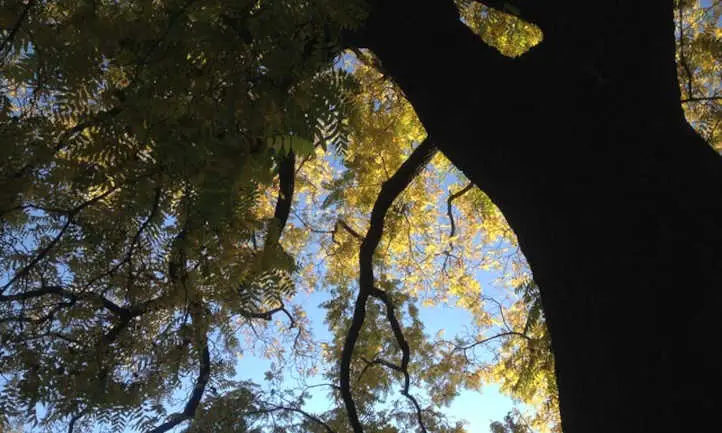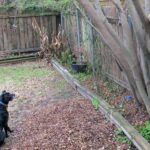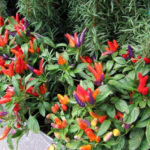If you’ve been in the shade of a black walnut tree, you know how lovely it is. Couple that with a black walnut harvest, and it’s easy to comprehend why walnut is a diet staple for people living in North America.
Not only are the nuts delicious, and full of nutrition, the trees are easy to grow. They are a pioneer species, sweeping through barren environments to take residence. The walnuts are also the main source of food for the eastern fox squirrel.
The black walnut tree gets a bad rap due to the natural herbicide it secretes in its leaves, nut husks, and roots. These parts irritate human skin and put livestock in peril. The herbicide also makes it difficult to grow other plants around the black walnut tree.
But don’t let that stop you! Black walnut trees have their disadvantages, but certain plants can survive around near them. As long as you’re careful and wear gloves, caring for them is a worthwhile (and tasty) endeavor.
Quick Care Guide

| Common Name(s) | Eastern black walnut |
| Scientific Name | Juglans nigra |
| Days to Harvest | 120 days |
| Light | Full sun |
| Water | Just above 2 inches per week |
| Soil | Fertile, well-draining |
| Fertilizer | Granular, high nitrogen |
| Pests | Black walnut curculio, walnut shoot moth, ambrosia beetle, squirrels |
| Diseases | Fusarium wilt, thousand cankers, nectria canker |
All About The Black Walnut Tree

The black walnut tree (Juglans nigra) is a native tree in the Eastern United States. You’ll find it thriving in riparian areas along river and creek banks. The black walnut has an established place among Apache peoples, who eat raw and cooked nuts in myriad ways and use them for topical medicine. Today, the black walnut thrives throughout temperate zones of North America. It’s used for its reliable hardwood. The nuts are also a prominent commercial crop the world over.
The black walnut tree is a deciduous tree that grows 25 to 100 feet tall. The black walnut roots are taproots, extending 10 feet underground. Because taproots make moisture retention difficult, the tree lives along river and creek banks. Dark green walnut leaves are compound, pinnate, and contain 15 to 23 toothed leaflets that are 1 to 2 feet long at maturity. They emerge in early spring from dense, hairy lateral buds. Terminal buds are heart-shaped and bundle together in threes. The tree’s canopy spreads as wide as it is tall.
In May through June, male and female black walnut flowers bloom with spiked female flowers and male catkins and are yellow-green in color. With successful pollination by wind or insects, walnut fruits form in September through October. Fruiting doesn’t occur until the 5th year of growth, and a full harvest may not occur until 20 years. The life span of a black walnut tree is roughly 100 years.
Juglans nigra trees are associated with the chemical juglone, which prevents the growth of certain other plant species. Juglone is secreted in the roots, walnut shells, and leaves. Nearby plants may experience herbicidal effects, but not all plants are susceptible to juglone. But there are many species of plants that don’t have susceptibility to juglone in their roots, and many are ground covers. So some plants are suitable in close proximity to black walnut.
The fruit husks are dangerous to livestock and pets. This sometimes causes seizures in dogs and laminitis and colic in horses. Juglone dissipates within 2 to 4 months, making trees and tree parts useful in well-aged compost.
Not only were Juglans nigra trees popular among Native Americans, but early settlers enjoyed the black walnut as well. Black walnut hardwood is also prized for its durability and is often used as a straight-grained veneer. The veneer is coveted among “walnut rustlers” who steal it from lumber yards. Non-veneer wood is used in furniture and fence posts.
Planting
Plant Juglans nigra saplings in fall. Avoid growing black walnuts in containers. They are too large. Instead, choose a site with at least 12 by 12 feet between each seed or sapling. Keep the tree out of direct winds in full sun, in well-draining, rich, and moist soil. Juglans nigra contains natural herbicides that slow growth of susceptible plants. Do not plant the tree near plants sensitive to juglone, especially other trees. Many plants can withstand juglone, but if you’re unsure, don’t risk it.
Dig a hole large and deep enough to accommodate the black walnut taproot without twisting or distorting it. Place the tree in the hole, and replace the dirt. When the hole is ⅔ full, add water, and press the soil down, removing any air pockets. Then fill in the remaining soil, mounding the dirt around the base of the tree, leaving a few inches between the trunk and the soil. Mulch well around the planting site for moisture retention.
Propagate black walnuts via grafting. Attach the twigs of viable, productive trees onto another rootstock, like English Walnut or Pecan. Select a length of twig that incorporates the current year’s growth. Cut 6 to 8 inches of twig with a sharp knife or pruning shears. Then make 3 vertical incisions in the bark of the rootstock, and cut the round end of the twig into a 45-degree angle. Put the cutting into the three-section and affix them together, wrapping them with aluminum foil. Then cover that with a plastic bag and tie it around the base. Within 3 to 4 weeks, new growth indicates a successful graft.
A Note on Planting Location
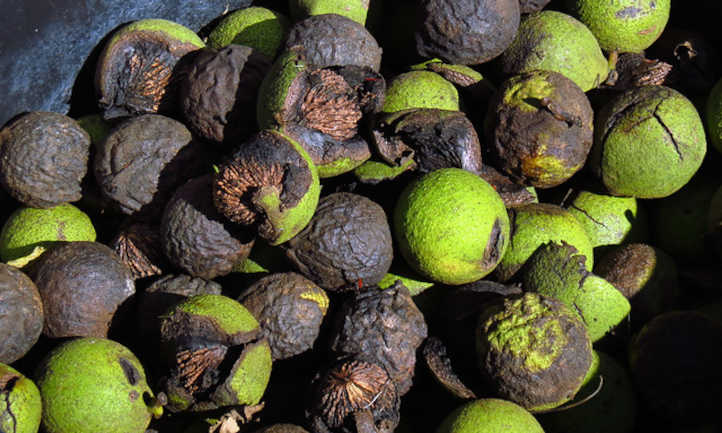
As we’ve mentioned, black walnut roots, walnut hulls, and leaves secrete the natural herbicide juglone. Other nut trees, young trees, and certain other plant species will have slowed growth or no growth as a result of planting near black walnut. The fruit husks are dangerous to livestock and pets. This sometimes causes seizures in dogs and laminitis and colic in horses. Do not plant this tree where pets and livestock can snack on any part of the tree. Always wear gloves when handling the husks as skin irritation and staining can occur from handling the husks.
English walnut trees are often grafted onto black walnut rootstock. While English walnut contains lower amounts of juglone than black walnut, it could be grafted onto black walnut.
Juglone deteriorates quickly, and mainly spreads through the root system around the tree. It’s possible to grow raised bed crops below the tree as long as leaves and husks are removed promptly after they fall. As long as you’re not going to use the compost from the tree parts immediately, it’s useful there. Walnut is not a good option for a food forest, because it takes 2 to 4 months for the juglone to leave the ground where a tree was planted.
There are many species of plants (many of them ground covers) that grow just fine in the ground around these trees. Here’s a quick list of some of the variety of plants that can grow within close proximity to black walnut, but there are others too!
Edibles:
Flowers:
Care

Let’s talk about how to care for black walnuts in your garden. With the right care, you’ll have a lovely, healthy tree, producing harvests for the rest of your life.
Sun and Temperature
The black walnut tree needs full sun to thrive, at a minimum of 6-8 hours of direct sun per day. Black walnuts grow best in zones 4 through 9. Established black walnut trees are adaptable to both tropical heat and sustained winters. Saplings have a harder time in cold and need a tree wrap. The black walnut tree does best when there are at least 170 frost-free days in a year. Ideal temperatures range between 45 and 65 degrees Fahrenheit. Sustained freezing temperatures at 28 to 32 degrees cause severe damage to the unprotected. The heat is no problem at all for this southern native tree.
Water and Humidity
A black walnut tree needs 1 inch of water per week, and a little more than 2 inches in its fruiting phase in summer. In most areas, spring and fall will be accompanied by enough rain to satisfy the 25-inch water requirement. Place a soaker hose or drip irrigation around the drip line of the tree, and water thoroughly in the morning to a depth of 3 to 6 feet once per week in spring and fall, and 2 to 3 times per week in summer. If it rains often, there’s no need to provide extra irrigation.
Soil
Ensure the place you planted your trees is rich in organic matter, loamy, and well-draining. If the earth is excessively sandy or silty, add some peat to retain moisture. Black walnut grows best in soil that was worked at least a few feet in. When you till, add in well-rotted compost, leaf mold, peat moss, and lime if the pH is highly acidic before planting. Black walnut grows best at a pH of 6.0 to 6.5 but tolerates 5.0 to 8.0. Compacted earth is no good for tree growth or producing fruit.
Fertilizing
To increase the growth rate of your trees, apply an ammonium sulfate granular fertilizer (21-0-0 NPK) in spring after the first year of growth. Always apply fertilizers at least 1 ½ feet away from the trunk of the trees. In the summer, as the tree begins to fruit, add a full spectrum granular fertilizer (15-15-15) in the same manner as the ammonium sulfate. Apply these fertilizers annually.
Pruning
In young trees, remove branches that point inward or downward. Cut the side branches to 6 inches to promote better fruit harvests. Wait until mature trees drop walnuts to the ground in fall to prune the branches. Remove stubby branches first at the trunk. Remove diseased and damaged branches or those that cross each other or the trunk of the tree. Prune side branches to be shorter than canopy branches. Remove suckers from the ground. Never prune more than 25% of the branches per year. Nuts drop from the tree when they’re ready for harvest, so no need to remove them. If you’re concerned about juglone in the garden, rake up the leaf matter, bark, and dropped twigs. The husks especially should be removed because they contain the highest concentration of herbicide.
Harvesting and Storing
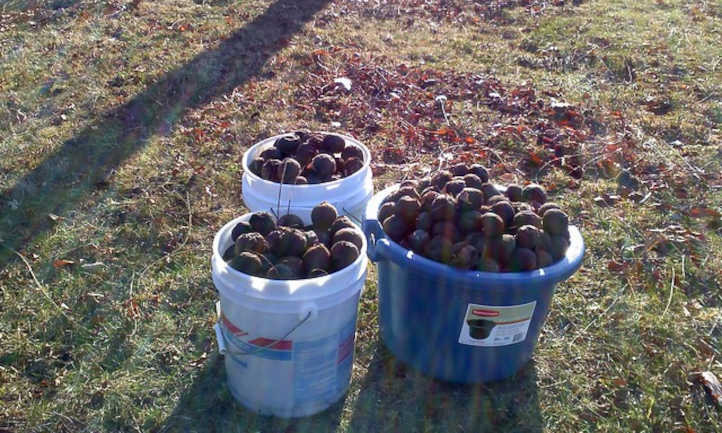
The best part of growing black walnut in the garden is the harvest! Here’s how to get nuts from your tall walnut tree, shell them, and extract them.
Harvesting
Walnuts drop from tall heights to the ground in their husks when they’re ready for harvest. Gather them in a basket in the early to mid-fall. Wear gloves when performing the harvest to ensure your hands are protected from irritants. Discard any damaged walnuts.
To hull them, either place them in a bag in your driveway, and drive over them, or drill a 1 ⅝ inch hole in plywood and hammer each through. Both methods remove the husks from the outer shell. Then, compost the remaining husks. Remember to allow the compost to break down for a few months before using it. Wash them, and cure walnuts that aren’t going to be eaten by laying them in a single layer in a cool dark place for several weeks.
One important post-harvest step involves raking up any hulls, brown leaves, and branches around the base of the tree. Especially if you’re growing tomatoes, peppers, butternut squash, certain shrubs, and pine trees, the removal of the tree matter will prevent herbicidal effects. Compost the tree matter for a few months, then screen out any remaining wood so it can continue to compost down.
Storing
Store walnuts inside their shell in burlap sacks at room temperature for up to 1 year. Allow shelled walnuts to dry for a day or two before storing them in the refrigerator in an airtight container for a few months. Frozen shelled nuts keep in jars or plastic bags for 2 or more years. Throw them into food as needed, and add nutrients to your favorite meals.
Troubleshooting
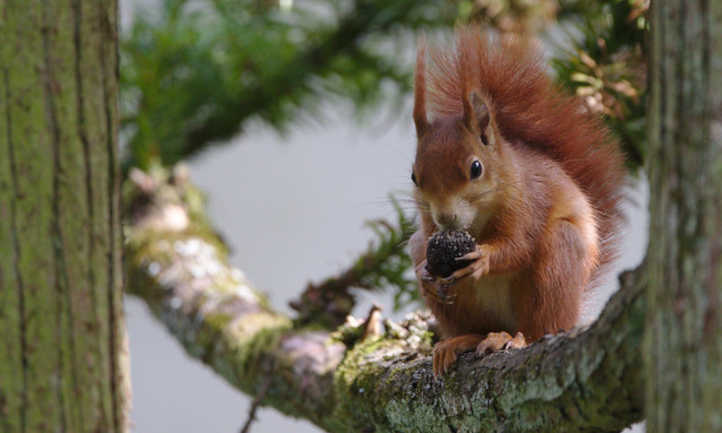
Problems sometimes happen when you grow a tall tree like black walnut. Here, we’ll discuss a few issues that can arise.
Growing Problems
If you planted at the wrong time or exposed a sapling to bitter cold, it takes on cold damage and may even die. Ensure there is a wrap present at planting in those zones that are prone to snap freezes.
When the tree doesn’t get enough moisture, it can get sunburned. Ensure you’re soaking the top 2 to 3 feet of the earth around mid-fall, especially in summer months.
The most common issue people experience when growing black walnut is damage to nearby plants due to juglone in the walnut’s roots and plant parts. Keep your pine, peppers, and tomatoes free of black walnut debris.
Pests
Black walnut curculio is a shield bug that feeds on the nutrients in walnuts, and deposits its larvae within them, damaging yields. The larva overwinters in the garden ground below. While there are no organic pesticides that reliably control curculio, manage them culturally by removing any prematurely fallen nuts as soon as possible, and disposing of them in the trash. Mow around the trunk regularly.
Walnut shoot moths and their reddish-brown larva feed on the flowers and buds of black walnut. They leave small round holes in buds, causing improper flower growth and lower yields. Remove any damaged parts of the plant as they show shoot moth damage. Then use corrective pruning in the dormant season to eliminate infestations. Spinosad is effective against the moths and their larvae.
Ambrosia beetles bore into trunks and may spread fungal spores in the process. Flooding is a condition in which these beetles thrive. Avoid waterlogging the garden when you water. They wilt foliage and leave boring dust outside the small holes they make. Bait them in early spring and late winter with ethanol traps. Pyrethrin sprays applied after you trap a few beetles control them and the fungus they spread. Reapply every two to three weeks until traps no longer have beetles in them.
Squirrels love to eat walnut fruit. They might even pelt you with a nut or two! To keep them off, live trap them and release them in a nearby squirrel habitat. In saplings, cover the fruit with a mesh bag. There’s not much you can do when squirrels want to get to nuts. In mature specimens, a little food for the squirrels won’t dampen your harvest.
Diseases
Fusarium wilt is a fungal soilborne disease. The fungus causes yellowing leaves, defoliation, and a wilting canopy. There is no treatment for fusarium, so prevention is essential. Ensure the ground is well-draining around the tree, and apply mycological bio-fungicides that will reduce the spread of fusarium fungi.
Thousand cankers is an aggressive fungal disease that affects single branches of plant species, shrubs, and nut trees causing yellowing and leaf wilting. If you notice scarring, wilting, and powdery white symptoms associated with thousand cankers, contact your agricultural extension office to determine the next steps. There is no cure for the disease.
Nectria canker appears as sore-like wounds on branches and trunks that develop into red, orange, and yellow fruiting bodies. This is caused by two different fungal pathogens and doesn’t have any associated treatment other than corrective pruning. An arborist should be consulted to discuss the cankering.
Frequently Asked Questions
Q: Can you eat black walnuts from a tree?
A: Yes, but hull and shell them first. Use gloves when handling hulls.
Q: How long does it take for juglone to break down?
A: 2 to 4 months.
Q: Are black walnuts poisonous?
A: Not to humans, but parts of the plants are toxic to livestock.
Q: Are black walnut trees toxic to dogs?
A: The husks are toxic to dogs. Fruits within the walnut shells may not be as toxic, but smaller dogs may be more susceptible than large dogs. Consult your vet if your dog consumes some of the shelled fruit. Alternatively, keep them away from pets altogether to avoid any issues.

